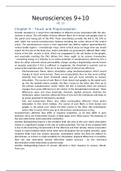Neurosciences 9+10
HC 12
Chapter 9 – Touch and Proprioception
Somatic sensation is a result from stimulation of afferent nerves associated with the skin,
muscles or joints. The cell bodies of these afferent fibers lie in dorsal root ganglia close to
the spinal cord, being part of the PNS. These nevertheless provide the link to the CNS as
well, which has several somatosensory features including the cortex dorsal of the central
sulcus. The somatosensory cortex is even separated into distinct regions representing the
various bodily regions – somatotropic maps. Some cortical areas are larger than you would
expect for the size of the body area. Action potentials are generated in afferent fibers after
events in the skin, muscle or joint, which are propagated to the cell bodies in the ganglia,
and eventually reaching the CNS. Before this, there ought to be sensory transduction
– converting energy of a stimulus to an action potential. In somatosensory afferents, this is
done via cation channels whose permeability change causing a depolarizing current known
as receptor potential. If this is sufficient in magnitude, the threshold is reached, and an
actual action potential arises. There are in fact two types of dorsal root afferents:
- Mechanosensory fibers: detect stimulation using mechanoreceptors which record
changes in touch and pressure. These are encapsulated, thus no free nerve ending,
whereby they have lower threshold values and are more sensitive to sensory
stimulation. The course of such fibers is from dorsal root ganglia, to the spinal cord,
up into the medulla where caudally, the fiber crosses to the other side, then up to
the primary somatosensory cortex. When the skin is touched, there are pressure
changes that causes differences in the stretch of the phospholipid membrane. These
differences open and close ionotropic channels; applied pressure stretches the
membrane, opens channels, allows the flow of ions over the membrane and leads to
an action potential (if threshold is reached).
- Pain and temperature fibers: also called nocireceptive afferents, these detect
stimulation in free nerve endings. The course of such fibers is from dorsal root
ganglia, in the spinal cord, where the fiber crosses to the other side immediately,
where after it moves all the way up to the primary somatosensory cortex.
Somatosensory afferents thus differ in response properties, as do they differ in axon
diameter; there are A-beta fibers (touch), A-delta (pain) and C-fibers (pain). The diameter of
the axon determines action potential conduction.
Another distinguishing feature is the receptive field: the area of skin over which stimulation
results in a significant change in the rate of action potentials. The size of the receptive field
is due to the branching characteristics of the afferents and their density. Dense innervation
results in small receptive fields, these need more stimulation but are highly sensitive. Large
receptive fields have low sensory precision, stimulations within the field are difficult to
discriminate, as is there is a high sensitivity for stimulation. Regional differences in receptive
field size and innervation density determine spatial accuracy – so, the two-point
discrimination varies extensively across the body.
Another distinguishing feature of sensory afferents is their response to sensory stimuli.
There are:





